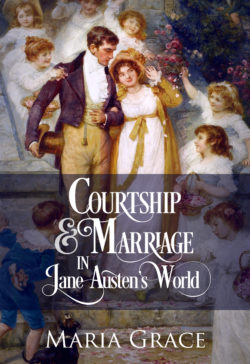Marriage and Coverture in Jane Austen’s World
It’s hard to believe how different women’s lives were in Austen’s day. Marriage and coverture, a legal concept, effectively took away her personhood.

The Concept of Coverture
In 1765, William Blackstone presented a common man’s language interpretation of English law. He explained the law’s approach to women’s legal existence and rights in marriage which remained largely unchanged until the Married Women’s Property Act of 1884.
Blackstone said:
By marriage, the husband and wife are one person in law: that is, the very being or legal existence of the woman is suspended during the marriage, or at least is incorporated and consolidated into that of the husband… and her condition during her marriage is called her coverture.
… For this reason, a man cannot grant anything to his wife, or enter into covenant with her: for the grant would be to suppose her separate existence; and to covenant with her, would be only to covenant with himself: … a husband may also bequeath anything to his wife by will; for that cannot take effect till the coverture is determined by his death.
… the chief legal effects of marriage during the coverture; upon which we may observe, that even the disabilities which the wife lies under are for the most part intended for her protection and benefit: so great a favourite is the female sex of the laws of England.
Effectively this common law doctrine rendered married women unable to sign bills of exchange, make contracts, buy property, write a will, act as a business partner, own her own earnings or have custody of her children. I’m not sure the law favored women the way Blackstone thought it did.
Ironically, single women and widows were able to act with much greater independence. In many cases widowhood gave a woman the greatest legal freedoms, which many wealthy widows were loath to give up by remarrying.
It was not until the Married Women’s Property Act of 1884 that married women enjoyed the same legal rights as unmarried women. That’s less than 150 years ago! Yikes!
Coverture and Domestic Abuse
Ironically, these favors and protections that Blackstone claimed for women actually opened the door for domestic abuse. Worse, they protected a husband’s right to hit his wife and made it very difficult for a wife to seek legal protection from her husband.
According to Blackstone (1765)
The husband also, by the old law, might give his wife moderate correction. For, as he is to answer for her misbehaviour, the law thought it reasonable to intrust him with this power of restraining her, by domestic chastisement, in the same moderation that a man is allowed to correct his apprentices or children; for whom the master or parent is also liable in some cases to answer.
But this power of correction was confined within reasonable bounds, and the husband was prohibited from using any violence to his wife, aliter quam ad virum, ex causa regiminis et castigationis uxoris suae, licite et rationabiliter pertinet.[ Otherwise than lawfully and reasonably belongs to the husband for the due government and correction of his wife.] The civil law gave the husband the same, or a larger, authority over his wife: allowing him, for some misdemeanors, flagellis et fustibus acriter verberare uxorem;[To beat his wife severely with scourges and sticks.] for others, only modicam castigationem adhibere. [To use moderate chastisement] (Translations from Latin, Jones, 1905)
In short, a man had the right to severely beat his wife if he deemed it appropriate. This made proving cruelty very difficult.
So much for Blackstone’s (1765) assertion: “so great a favourite is the female sex of the laws of England.”
It is comforting to remember that Judge Buller amended this understanding somewhat, with his ‘rule of thumb’: A man could thrash his wife with a stick no thicker than his thumb.
Ironically, instead of improving women’s lot, the ideals of companionate marriage may have made domestic violence worse. The incompatible expectations of men raised in a patriarchal tradition, legal coverture, and the social enlightenment were ripe to create tensions that could easily explode into violence.
A woman could petition the court that her husband inflicted cruel and unjust harm upon her. She could charge her husband with assault and battery or could ‘swear the peace’ by which a court could order her husband to keep the peace if he had inflicted physical injury, imprisonment or some other cruelty on her. (Laudermilk,1989) But to get the sympathy of the court, women had to paint themselves as passive and dutiful victims of truly inhumane treatment. It could be done, but it was difficult at best as evidenced in that of the three hundred twenty four divorces granted between 1670 and 1857, only four were granted to women. (Wright, 2004)
Kind of makes the era a little less romantic, huh?
Find References Here!
To Read more articles on weddings, click here.
To read more articles on courtship click here.
To read more articles on marriage click here.
Want to learn more? Try Courtship and Marriage in Jane Austen’s World, available in ebook and paperback
.
Please support this author and website by using this affiliate link.

I’m so glad I live in the 21st century!
Me too!
I hear you, Anji. 🙂
🙂
Not romantic to begin with as I always think of the hygiene and lack of medical knowledge (bleeding), etc. But we still see abuse today as most men are stronger than their wives….I worked as a caseworker for Children, Youth & Families and witnessed the results of physical, emotional and sexual abuse. Thanks for sharing.
Sadly I’ve witnessed quite a bit of that. Some things don’t seem to change. 🙁